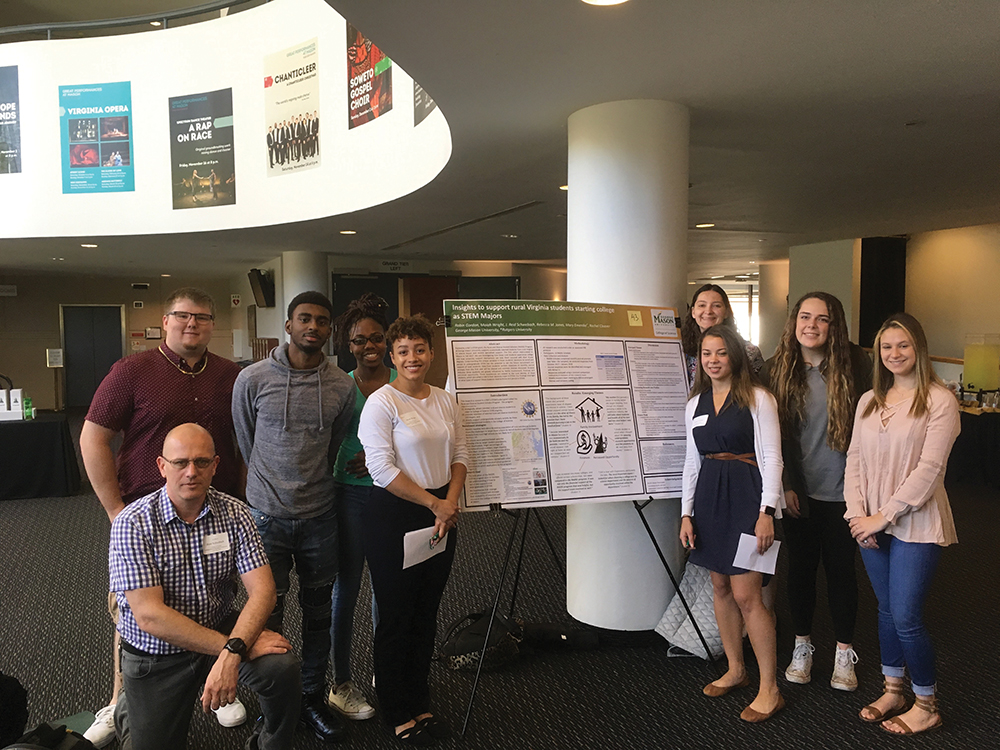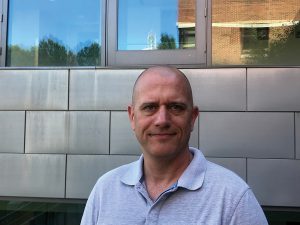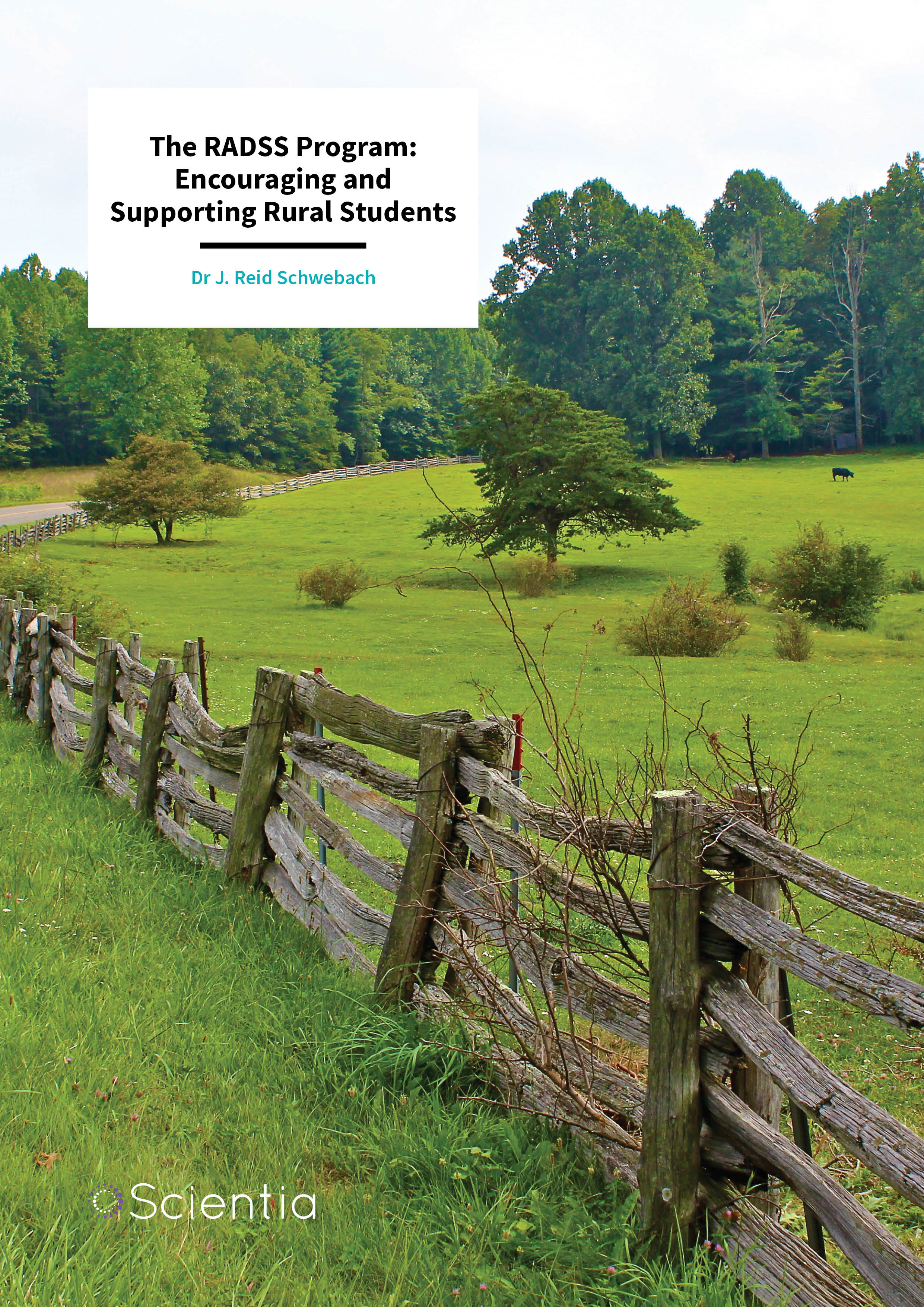Dr J. Reid Schwebach – The RADSS Program: Encouraging and Supporting Rural Students
Rural youth often lack the financial resources needed to study at university. In fact, their path to higher education is brimming with obstacles. Through the Rural and Diverse Student Scholars (RADSS) program, Dr J. Reid Schwebach and his team at George Mason University are seeking to remove these obstacles and encourage students throughout rural Virginia to pursue further studies and employment in STEM-related fields.
Accessing Education
Ensuring that young people have unhindered access to education continues to be a challenge. This is especially true in the case of students who have limited financial resources. The UNESCO Education Strategy for 2014–2021 acknowledges that, ‘the gap in learning outcomes between rich and poor – within and between countries – is high and often growing.’ It also relates that, because of limited access to education, ‘unemployment and underemployment are too often experienced disproportionately by girls and women, the poor, the disabled and rural populations.’
Clearly, there is an ongoing need to encourage and support rural youth in their quest for a good education, especially those from diverse backgrounds and with limited financial resources. Furthermore, there is a need to encourage students who have a passion for STEM-related fields to pursue study and employment, to ensure a thriving STEM workforce into the future.
In response to this need, Dr J. Reid Schwebach from George Mason University created the Rural and Diverse Student Scholars (RADSS) program. RADSS aims to encourage academically talented students from rural areas in the state of Virginia to attend Mason’s College of Science (COS). Specifically, the main objectives of RADSS are: (1) to strategically attract talented rural and diverse students to major in COS degrees, (2) to promote retention of talented rural and diverse students in COS majors, and (3) to directly support undergraduate scholarly activity in the COS. RADSS is supported with financial aid from the National Science Foundation (NSF). It is also supported by the 4-VA organisation – a collaborative partnership between six Virginian universities that is working to improve higher education across the state.
‘We are investigating how these rural students experience college and how university support mechanisms can help them succeed with their four-year degrees. Understanding the unique variables in these students’ decisions to enrol and persist in undergraduate STEM has the potential to aid the future recruitment and support of rural students.’
Through RADSS and associated research, Dr Schwebach and his colleagues are also collecting data and feedback to better understand the obstacles that rural students face in general, and how they can be assisted to overcome them. ‘We are investigating how these rural students experience college and how university support mechanisms can help them succeed with their four-year degrees,’ Dr Schwebach explains. The goal? ‘Understanding the unique variables in these students’ decisions to enrol and persist in undergraduate STEM has the potential to aid future recruitment and support of rural students,’ he said. So, in addition to giving support to current RADSS participants, Dr Schwebach hopes to fine-tune his program and improve future recruitment efforts.

Obstacles Facing Rural American Students
Despite the United States having an excellent higher education system overall, talented rural students from various regions are still facing financial challenges and a lack of opportunity. A recent report prepared by the School Superintendents Association, entitled ‘Levelling the Playing Field for Rural Students’, highlighted that rural children face greater levels of poverty than their peers.
In 2015, child poverty rates were 24 per cent in non-metropolitan areas compared with 20 per cent in metropolitan areas. In addition, rural school districts tend to be geographically large, adding increased costs for transport, technology, and learning materials. A lack of financial resources, in turn, affects enrolment rates, retention rates and students’ motivation to engage with their studies. The report also highlighted that rural students are less likely to enrol in college and may lack the required role models and support to take up further studies.
The report concluded, ‘the challenges students face in many rural places are staggering. Limited access to advanced coursework, medical care, food and employment opportunities, continue to daunt students in many rural communities.’ Furthermore, as Dr Schwebach highlighted, research indicates that rural students in the United States are less likely to major in STEM subjects. As far as the state of Virginia is concerned, few rural students are headed to Mason to study at all, let alone to study at the COS. And so, the RADSS program was born.

About the RADSS Program
RADSS aims to encourage academically talented students from rural Virginia to attend Mason. The program does this by offering scholarships and research experiences to rural and diverse undergraduates with demonstrated financial need, and who wish to major in degrees such as astronomy, biology, chemistry, environmental science, mathematics, geology and physics. During their studies, these students also receive specialised support and mentoring to ensure that they remain positive about their learning.
In the initial stages, the RADSS program provides scholarships of 5000 USD for two cohorts of ten incoming freshmen who complete a summer bridge program before their first full academic year. Then, students complete a transition to a university course during their incoming semester. Students are mentored and supported by RADSS undergraduate Learning Assistants for four years. Provided students demonstrate that they are benefiting from the program, and provided they are in good academic standing, they receive an additional 5000 USD in scholarship funding for years two, three and four of their studies. Scholars can also participate in summer undergraduate research supported by academic and industry partners.
Fine-tuning the program and improving future recruitment strategies based on community feedback is also a central component of RADSS. Therefore, the program has two additional components. The first is to create and investigate a general, state-wide recruitment mechanism to attract rural students to major in a STEM subject at a college away from home. The second is to investigate how students from rural backgrounds form their identity and find their place in college, to understand how best to support these students’ academic success. Of course, in collaboration with other institutions, the program will also provide a model for supporting recruitment and retention of students in STEM degrees throughout the rural areas of the United States.
Another notable feature of the RADSS program is that it builds capacity at Mason to form partnerships with regional laboratories and industries. These partnerships provide opportunities for students to gain research experience and to be mentored by those working in relevant fields. In addition to the skills and knowledge gained, these experiences will help students to network, likely increasing their employment prospects after graduating.

What the RADSS Program Tells Us
The program is currently in its early days. However, Dr Schwebach and his colleagues have accomplished much, and have reached several significant milestones. First, the recruitment method has been successfully implemented across 10 schools in Virginia. The team has identified an applicant pool and has already offered several scholarships to selected students. Although there are still scholarships on offer for the first cohort, the team is processing applications from interested persons and will continue to select students and facilitate their transition to Mason.
As far as understanding the unique variables and challenges that rural youth face on their path to higher education, initial community feedback from the RADSS program has been most enlightening. Firstly, it has shown that rural students are indeed greatly influenced by family involvement, finances, and perceived opportunity, which in turn, affects their motivation to study at university. For example, some students commented how they felt that their hometown lacked opportunity completely, or that opportunities were totally inaccessible.
Secondly, initial feedback has shown that financial and study support, as well as research opportunities, are critical to overcoming many of the obstacles facing rural youth and encouraging their academic pursuits. The comments and sentiments of students highlight that this is very much the case:
‘I became interested in Mason because it was economically fit for both me and my parents. I wanted to enrol because I felt right at home as soon as I stepped foot on campus.’ (Student C)
‘I finally decided to enrol when I thought about the amazing undergraduate research opportunities and the proximity to DC (and away from home).’ (Student E)
‘I was accepted into many colleges, and offered various scholarships, but none compared to the RADSS program. It was not only the financial support of the RADSS program that was helpful, but the support team involved as well. The most important aspect I looked for when choosing a college was its science department and the amount of opportunity involved within the department.’ (Student D)

Onwards and Upwards with RADSS
Dr Schwebach and his colleagues have much work to do. When asked about the next steps in their work, Dr Schwebach explained that, ‘a rural student’s identity as “rural” is unique to each rural student; being “rural” is not a singular definition. Hence, we are investigating “what works” for these students to be supported in STEM at university, with our theory being that the Learning Assistant program and support of these students as a cohort with additional faculty advising will significantly impact student success.’ And of course, there is much work remaining to ensure that the rollout of RADSS is as smooth as possible, and to collect data and feedback from participants.
Nevertheless, RADSS is already having a positive effect. As implementation progresses, it will undoubtedly continue to assist rural students to follow their passion for STEM-related fields of study and employment. It is also shedding light on the obstacles faced by rural youth on their path to a quality, individualised education. Of course, the insights gained will further improve future recruitment efforts, and many other academic institutions could also benefit from the lessons learnt.
In conclusion, in light of ongoing issues related to accessibility, we applaud the efforts of researchers and educators from around the world to improve the situation. Indeed, there is a need to encourage and support rural youth, particularly from diverse backgrounds and with limited financial resources, into STEM-related fields of study and employment. Programs such as RADSS aim to do exactly that and will continue to ensure that equity in education is improved and maintained.
Meet the researcher

Dr J. Reid Schwebach
College of Science
George Mason University
Fairfax, VA
USA
Dr J. Reid Schwebach received his PhD in in microbiology and immunology from the Albert Einstein College of Medicine in 2002. He also holds an EdM degree in secondary science education and an MA degree in international education development. Before coming to George Mason University, he taught high-school chemistry and independent student research at The Beacon School, New York. He also worked for the Board on Science Education at The National Research Council as a program officer and study director. From 2007 until 2008, he was a Science and Technology Policy Fellow at the National Science Foundation in The Division of Research and Learning. He currently serves as Assistant Professor at Mason’s Department of Biology, Program Manager of Teacher Engagement and High School Partnerships at Mason’s College of Science, and Coordinator of The Governor’s School, Innovation Park – a dual-enrolment public high-school at Mason.
CONTACT
E: jschweba@gmu.edu
W: https://biology.gmu.edu/j-reid-schwebach/
KEY COLLABORATORS
Additional colleagues on the project deserve acknowledgement for their contributions to the RADSS Program: Dr Rachel Cleaver and Dr Rebecca Jones of George Mason University, and Dr Mary Emenike of Rutgers University.
FUNDING
National Science Foundation (NSF)
4-VA
George Mason University’s Office of Student Scholarship, Creative Activities, and Research (OSCAR)
Dr Schwebach would like to thank 4-VA (https://4-va.org/) for support to fund the publication of this article. We acknowledge NSF #1564989 for supporting the RADSS Scholars and the RADSS Program.
Dr J. Reid Schwebach is transitioning to a new position at the American Association for the Advancement of Science (AAAS) effective 8/27/2018, and future interest in the RADSS program at Mason should be directed to Padmanabhan (Padhu) Seshaiyer, email: pseshaiy@gmu.edu.



